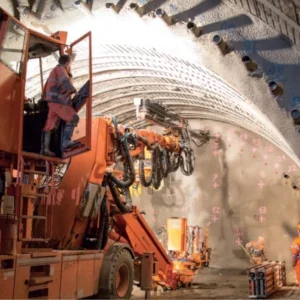Arecent consultant’s article (Pells, T&TI March, p34(10)) and an experienced contractor’s reactions (Garshol, T&TI May, p36(8)) has again put the focus on pre-grouting ahead of tunnels. Garshol emphasised the need to use high pressures to get an acceptable result. The proviso is of course that the work is done ahead of the face (as in most of Garshol’s excellent grouting case records) and not from behind the face where lower pressures have to be used (as in most of Pell’s case records).
With a rule for injection pressure gradients of 0.23 bars/m depth for dam foundation grouting in the US, but usually higher elsewhere, it is clear that there will be reactions when 50 to 100 bars is recommended by an experienced contractor for a stretch of tunnel whose 20m depth suggests only 5 bars.
The reasons for performing high pressure (50 to 100 bars) injection when pre-grouting ahead of tunnels is that inflows have to be controlled, perhaps down to 1 to 2lt/min/100m. Permeabilities lower than 10-8m/s or lower than 0.1 Lugeon are implied – and these are also achieved when reluctant owners and consultants become aware of what is achievable today, with stable ultrafine and microcements and the vitally necessary additives like microsilica and plasticizers and necessary additives like treated microsilica, plasticisers and dispergents .
It has been found from recent Norwegian tunnelling projects that high pressure pre-injection may be fundamental to a good result, i.e. much reduced inflow and improved stability. The pressures used are far higher than traditionally used at dam sites, where in Europe, Brazil and the US, maximum grouting pressures (for deep dam foundations) have been limited to about 0.1, 0.05 and 0.023MPa/m depth respectively (Quadros and Abrahão, 2002(12)).
According to a recent report by Klüver (2000(9)), a shallow tunnel in phyllite with 5m of cover, with severe environmental requirements for low inflow, was injected at invert level to a final pressure of 6.5MPa and to 5MPa even at the shallow depth of the arch, only 5m below the surface (however, establishment of an outer screen was advised by Klüver in such extreme situations).
The reality is that while grout is still flowing, there is such a steep pressure gradient away from the injection holes (from logarithmic to linear depending on joint intersection angle) that ‘damage’ to the rock mass is limited to local, near-borehole, joint aperture increase.
Measurements in Norway have also shown that there can be a pressure drop of 1MPa up to the injection point for these low w/c ratio, frictional-and-cohesive fluids (Åndal et al, 2001(14)). So with at least 40% to 80% pressure drop in the first 1m radius from an injection hole, even for Newtonian fluids like water, it is clear that at the very minimum, an excess pressure of 25 bars may be needed to inject significant volumes of grout into connected joint planes and flow channels.
On at least one joint set there may be local shear and dilation. Each of these effects is probably in the region of small fractions of a mm, judging by the average grout take of numerous rock masses. About 1 to 5lt/m³ of rock mass is typical, if we assume that a 6m thick cylinder of rock around the tunnel has been thoroughly injected (Barton, 2003).
Some pre-grouting results
From recent compilations of practical experiences, we can derive from Åndal et al, 2001(14) the following quantities of grout used in successful, high pressure pre-injection.
Values in parentheses signify presumed ‘escape’ of grout in these two cases, and break-down of the ‘6m grouted cylinder’ assumption. A certain percentage of leaking bolt holes of 4m to 5m length is the logic behind an average choice of a 6m cylinder. We can see from Table 1 that 1-5lt of grout per m³ of rock mass is a typical range, for projects where post-grouting water leakages were mostly in the desired range of 1 to 4lt/min/100m of tunnel. Tunnel cross-sections were mostly 65m² to 95m².
Note that an average pre-grouting screen of 25m length, with 30 holes of 50mm diameter will require at least 1,500lt of grout just to fill the holes.
When distributed through an assumed 6m thick cylindrical volume of 25m length, this nevertheless represents only about 0.1lt/m³, so hardly affecting the above ‘rule-of-thumb’ result of between 1 and 5lt/m³. Tunnels with poor grouting results may typically lie a long way below 1lt/m³ in injected volume, resulting in poor connection between the grout ‘lenses’ and possible (continued) wet conditions as a result.
A simplified model for visualising grout penetration
Because the author and readers of this magazine are engineers, a practical, calculable model is required for first pass estimates of grouting needs. For this reason a simple, classical model from Snow (1968(13)) has been applied, with two important additions, namely the differentiation of hydraulic (e) and physical (E) average apertures, and the recognition that deformation (local joint opening) can occur. Figure 2 shows the cubic network concept and the E > e concept.
Assuming the cubic law is sufficiently valid for engineering purposes that we can ignore non-linear or turbulent flow, we can write permeability K = e2/12 for one parallel plate, while
[See equation 1 – to the left]for one set of parallel plates of mean spacing (S). Snow (1968(13)) further assumed that the ‘rock mass permeability’ would be constituted, on average, by flow along two of the three sets of parallel plates. Thus:
[See equation 2 – to the left]Making further simplifications that 1 Lugeon ? 10-7m/s ? 10-14m², therefore 1 Lugeon ? 10-8mm², we can finally write the simplified relation:
[See equation 3 – to the left]where (e) and (S) are in mm, and L is the average number of Lugeon (each of the above apply to a given structural domain, to the whole borehole, or to a specific rock type).
From equation 3, five examples of (e) and (S) are derived. These are shown in Figure 3, assuming a typical range of (average) S = 0.5m-3.0m. Although hydraulic aperture (e) is not strictly a ‘groutable aperture’, it is easy to imagine the likely difficulties of grouting rock masses of less than 1.0 Lugeon, unless we can argue for E > e, or can increase E by using higher pre-grouting pressures than in the Lugeon test. We will return to both these important aspects in a moment.
Roughness, apertures and particle sizes
The potential difference between (E) and (e) has been shown to be dependent on the joint roughness, as shown in Figure 4 and a simple rearrangement of the empirical equation:
[See equation 4 – to the left]The groutable porosity for three assumed sets of joints in Figure 2 can, in principle, be written:
[See equation 5 – to the left]when assuming an average cubic network, and that (E) gives the average joint space available for flow and for grouting. Clearly this is a tenuous assumption, as the real aperture available for water flow has a distribution of apertures, and as contact points are approached, larger grout particles will be blocked. This is another reason for increasing injection pressures.
We can note that average grouted apertures (E) of 333µm at 1m intervals in three perpendicular directions (the cubic model) are suggested by 1.0lt/m³ of grout. It is therefore clear that joint deformation is taking place (most likely on most of the water conducting sets). Shear and dilation is also a likely, local mechanism, for at least one of the inclined joint directions depicted in Figure 1.
The value of JRC0 can be estimated from (a/L) x 400 (at 100mm length scale), using profiling. A broad selection of joint roughness measurements in 1000m of core by Barton (2002(4)), revealed an approximate relationship between JRC0 and Jr (‘joint roughness number’) from the Q-system. This can be used prior to more accurate profiling methods.
[See equation 6 – to the left]Which hydraulic aperture (e) will be approximately equivalent to, for instance E ? 50µm. The answer is ‘many possible apertures’, because of joint wall roughness JRC0. Barton and Quadros (1997(2)) showed that JRC0, which is proportional to amplitude of roughness (a) divided by length of profile (Ln), is equivalent to the classic ‘relative roughness’ used in hydraulics. From equation 4 we see some of the possible solutions for hydraulic apertures (e) equivalent to E = 50µm in Table 2.
Joint entry by the grout particles is depicted schematically in Figure 5. Firstly, a micro cement with d95 = 30 microns may well penetrate a joint with e = 25 microns – it is a question of roughness, because E may be >>25 microns. Secondly, there is a certain logic (boundary layer theory) and experimental evidence (Bhasin et al, 2002æ), for blocked entry (i.e. filtering) if E < 3 x dmax (if there are sufficient numbers of dmax particles). A modified rule-of-thumb for joint entry limits that is easier to use, as d95 is easier to measure, is that:
[See equation 7 – to the left]When for instance, d95 = 12µm, and dmax = 16µm (as for a typical ultra-fine cement), these relations both suggest great difficulty when E ? 50µm. However a very high water/cement+filler ratio can ‘over-rule’ here, just as a busy city street could easily allow all vehicles to pass fast, if they came ‘one-at-a-time’. This would be no way to ‘block the street’ however – the objective here.
The above suggests joint roughness assessment is fundamental to the interpretation of Lugeon tests, as it may help not only to decide upon which types of grout (ultrafine, microfine, industrial cement etc.), but also whether high pressures will be needed.
For example, from Figures 3 and 4 : if L = 1.0, S = 1.5m and e = 45µm (average values for a given domain) and further, if JRC0 is only 3 or 4 (or Jr ? 1), we would be unlikely to get a successful grouting result even with ultrafine (d95 = 12µm), unless we deformed the joints using high injection pressures, we fail, due to equation 7 size limitations.
Related Files
Equation 2
Equation 6
Fig 5 – The inequality of (e) and (E) and the E > 4 d95 entry limit, due to particles ‘delayed’ on the rough walls of the joint
Fig 4 – The inequality of (E) and (e) for mated joints under normal closure (or opening) is a function of joint roughness coefficient JRC0. (Barton et al, 1985(1))
Equation 1
Equation 7
Table 2
Equation 3
Equation 4
Fig 1 – Sources of pressure drop and joint entry problems (Barton, 2003)
Fig 3 – Derivation of mean hydraulic apertures (e) and mean spacings (S) from Snow (1968(14)) equations
Equation 5
Table 1
Fig 2 – Cubic network model of Snow (1968[14]), and definitions of e and E, from Barton et al (1985(1))






